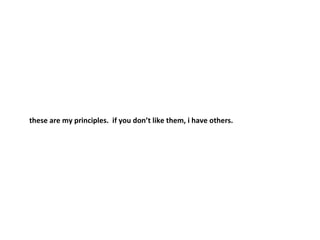
Principles
- 1. these are my principles. if you don’t like them, i have others.
- 3. messiness gnarl greeble attractor dual process black swan emergence co-evolution distributed representation resilience mece uncontrollability revenge effect
- 4. messiness - the world is a complex mess of tied, linked, interactive and knotted ever-changing systems we don’t understand too well and we can only control a little.
- 6. gnarl - something twisted and tight and swollen; "their muscles stood out in knots"; "the old man's fists were two great gnarls"; "his stomach was in knots” - distorted shape, distortion - a shape resulting from distortion
- 8. greeble - a small piece of detailing added to break up the surface of an object to add visual interest to a surface or object, particularly in movie special effects. they serve no real purpose other than to add complexity to the object, and cause the flow of the eye over the surface of the object to be interrupted, usually giving the impression of increased size.
- 10. attractor - is a more or less stable phase to which a dynamical system evolves after a long enough time. that is, points that get close enough to the attractor phase remain close even if slightly disturbed.
- 12. dual process - in psychology, a theory that provides an account of how a phenomenon can occur in two different ways, or as a result of two different processes. the two processes consist of an automatic, unconscious process and a controlled, conscious process.
- 14. black swan - a large-impact, hard-to-predict, and rare event beyond the realm of normal expectations.
- 16. emergence - the way complex systems and patterns arise out of a multiplicity of relatively simple interactions. emergence is central to the theories of complex systems.
- 18. coevolution - the change of a biological object triggered by the change of a related object. each party in a coevolutionary relationship exerts selective pressures on the other, thereby affecting each others' evolution.
- 20. distributed representation - meaning that is not captured by a single symbolic unit, but rather arises from the interaction of a set of units, normally in a network of some sort. in the case of the brain, the concept of ‘ grandmother’ does not seem to be represented by a single ‘grandmother cell,’ but is rather distributed across a network of neurons.
- 22. resilience - the capacity of a system to tolerate disturbance without collapsing, to withstand shocks, to rebuild itself when necessary, and to improve itself when possible.
- 24. mece - mutually exclusive and collectively exhaustive, is a grouping principle which says that data in a group should be divided into subgroups that comprehensively represent that group (no gaps) without overlapping. This is desirable for the purpose of analysis, because it avoids both the problem of double counting and the risk of overlooking information.
- 26. uncontrolability – as our machines and institutions grow towards complex, self-sustaining systems, we have to make them more biological in order to manage them. this means we can only give these systems guidelines and allow them self-governance, relinquishing some of our total control.
- 28. revenge effect - while solving one problem, solutions sometimes generate more problems in some cases the new problems are bigger, worse, or more complicated than the original problem. "to fix something more broken"
